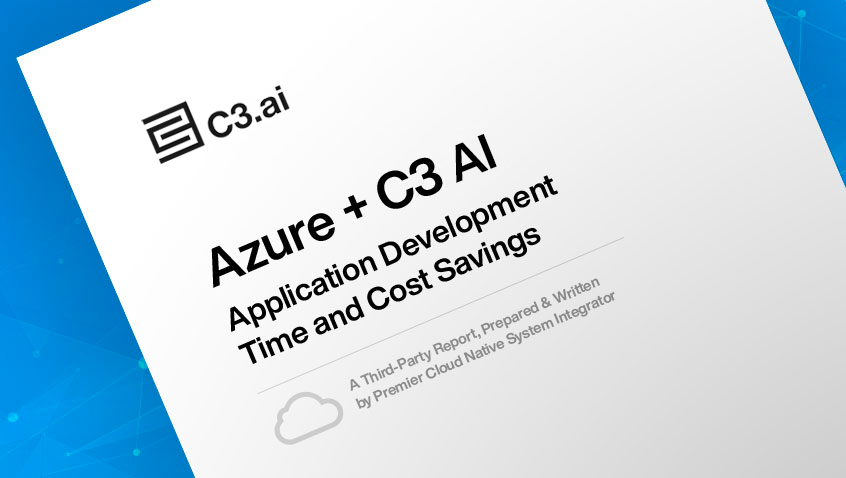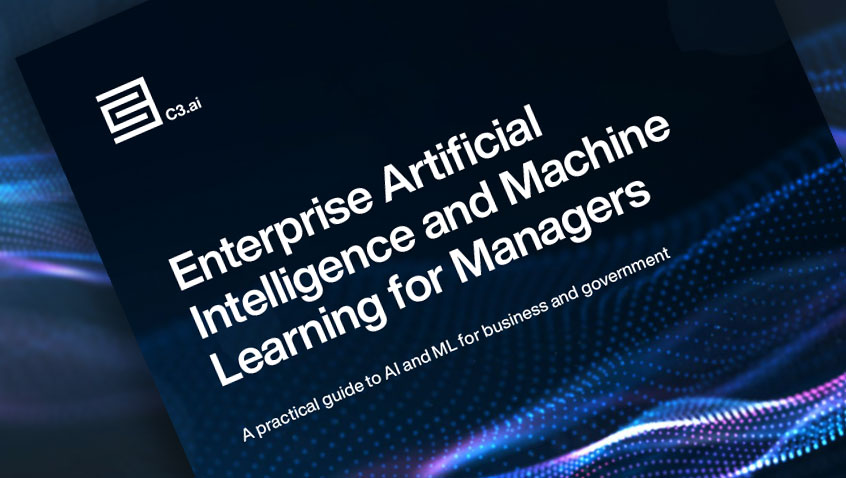- AI Software
- C3 AI Applications
- C3 AI Applications Overview
- C3 AI Anti-Money Laundering
- C3 AI Cash Management
- C3 AI Contested Logistics
- C3 AI CRM
- C3 AI Decision Advantage
- C3 AI Demand Forecasting
- C3 AI Energy Management
- C3 AI ESG
- C3 AI Health
- C3 AI Intelligence Analysis
- C3 AI Inventory Optimization
- C3 AI Process Optimization
- C3 AI Production Schedule Optimization
- C3 AI Property Appraisal
- C3 AI Readiness
- C3 AI Reliability
- C3 AI Smart Lending
- C3 AI Sourcing Optimization
- C3 AI Supply Network Risk
- C3 AI Turnaround Optimization
- C3 Generative AI Constituent Services
- C3 Law Enforcement
- C3 Agentic AI Platform
- C3 Generative AI
- Get Started with a C3 AI Pilot
- Industries
- Customers
- Events
- Resources
- Generative AI for Business
- Generative AI for Business
- C3 Generative AI: How Is It Unique?
- Reimagining the Enterprise with AI
- What To Consider When Using Generative AI
- Why Generative AI Is ‘Like the Internet Circa 1996’
- Can the Generative AI Hallucination Problem be Overcome?
- Transforming Healthcare Operations with Generative AI
- Data Avalanche to Strategic Advantage: Generative AI in Supply Chains
- Supply Chains for a Dangerous World: ‘Flexible, Resilient, Powered by AI’
- LLMs Pose Major Security Risks, Serving As ‘Attack Vectors’
- What Is Enterprise AI?
- Machine Learning
- Introduction
- What is Machine Learning?
- Tuning a Machine Learning Model
- Evaluating Model Performance
- Runtimes and Compute Requirements
- Selecting the Right AI/ML Problems
- Best Practices in Prototyping
- Best Practices in Ongoing Operations
- Building a Strong Team
- About the Author
- References
- Download eBook
- All Resources
- Publications
- Customer Viewpoints
- Blog
- Glossary
- Developer Portal
- Generative AI for Business
- News
- Company
- Contact Us
Glossary
- Artificial Intelligence
- AI Agents
- AI in Finance
- AI in Manufacturing
- Anomaly Detection
- Anti-Money Laundering
- Asset Performance Management
- Asset Reliability
- Demand Forecasting
- Digital Disruption
- Digital Transformation
- Digital Twin
- Elastic Cloud Computing
- Energy Management
- Enterprise AI
- Enterprise AI Platform
- Ethical AI
- Inventory Planning
- IoT Platform
- Know Your Customer (KYC)
- Machine Vision (Computer Vision)
- Model-Driven Architecture
- Multi-Cloud
- No Code
- Predictive Analytics
- Predictive Maintenance
- Process Optimization
- Production Scheduling
- Stochastic Optimization
- Supply Chain Management
- Type System
- Data Unification & Management
- Machine Learning (A to L)
- Artificial General Intelligence
- Bias
- Canonical Schema
- Canonical Transform
- Classification
- Classifier
- Classifier Performance
- Clustering
- Coefficient of Discrimination, R-Squared (R2)
- Convolutional Neural Network (CNN)
- Correlation
- Data Cleansing
- Data Labels
- Data Lineage
- Deep Learning
- Dimensionality Reduction
- Explainable AI
- F1 Score
- False Positive Rate
- Feature Engineering
- Feedback Loop
- Field Validation
- Gaussian Mixture Model (GMM)
- Generalized Linear Models
- Gradient-Boosted Decision Trees (GBDT)
- Features
- Ground Truth
- Holdout Data
- Hyperparameters
- Information Leakage
- LIME: Local Interpretable Model-Agnostic Explanations
- Linear Regression
- Loss Function
- Low-Dimensional Representation
- Machine Learning (M to Z)
- Mean Absolute Error
- Mean Absolute Percent Error
- Machine Learning Pipeline
- Model Drift
- Model Prototyping
- Model Training
- Model Validation
- Normalization
- Overfitting
- Precision
- Problem Tractability
- Random Forest
- Recall
- Receiver Operating Characteristic (ROC) Curve
- Regression Performance
- Regularization
- Reinforcement Learning
- Reporting Bias
- Ridge Regression
- Root Mean Square Error (RMSE)
- Selection Bias
- Shapley Values
- Supervised Machine Learning
- Tree-Based Models
- Underfitting
- Unsupervised Machine Learning
- XGBoost
Supply Chain Management
What is supply chain management?
Supply chain management is the oversight and management of the flow of goods, information, and sales as they move from suppliers to consumers. Supply chain management encompasses the planning and management of all supply chain activities involved in sourcing, procurement, conversion, and logistics management, with the goal of improving efficiency, reducing costs, and ensuring the timely delivery of products.
How is supply chain management different from supply chain planning?
Supply chain management and supply chain planning refer to similar and overlapping business processes. However, there are a few key differences. Supply chain management encompasses the end-to-end oversight and coordination of all activities across the supply network, while supply chain planning is a subset of the process that focuses on strategic planning of the activities.
Supply chain planning is a strategic process of organizing resources and inventory to optimize manufacturing and delivery of goods to meet customer demand. It involves multiple activities, including:
- forecasting customer demand
- managing inventory levels based on the forecast
- planning production schedules
- developing distribution strategies
Supply chain management covers the entire fulfillment process from raw material procurement to final product delivery and after-sales services. In contrast, supply chain planning addresses medium to long-term planning horizons, focusing on demand forecasting and aligning supply to meet anticipated needs. Essentially, supply chain planning is a critical component within the overarching supply chain management accountability and provides the necessary insights and strategy to enhance operational efficiency and responsiveness.
What is supply chain management software?
Supply chain management software helps organizations manage and optimize supply chain operations by providing real-time visibility, enhancing coordination among stakeholders, and automating processes. By leveraging advanced technologies, supply chain management software supports different phases of supply chain management process to improve overall efficiency.
Supply chain management software improves demand planning by analyzing historical data and market trends to allocate resources effectively and optimize inventory levels. This helps organizations to increase cost savings and meet customer satisfaction. It streamlines procurement by automating processes and real-time tracking to maintain a steady supply of resources and reduce risks, which in turn optimizes production schedules based on the demand forecasts and resource availability. The software increases productivity by enabling businesses to quickly adapt to changes in demand for unexpected disruptions and integrating quality control measures to ensure products meet desired standards.
Why is supply chain management software important?
Supply chain management software plays a crucial role in modern supply chain operations by providing the tools needed to manage complexity, reduce risks, and improve efficiency. It enables organizations to gain real-time insights, automate processes, and make data-driven decisions that improve operational performance to stay agile and resilient.
By using a supply chain management software, organizations can:
- Meet production demand by ensuring supply chain links function properly, fulfilling orders and satisfying customer needs.
- Gain enhanced visibility into supply chain operations, allowing for better monitoring and management.
- Mitigate risks by proactively identifying potential disruptions and providing solutions.
- Make better decisions with accurate real-time data, enhancing overall supply chain performance.
- Increase agility and resilience by adapting to market shifts and disruptions.
What is AI-driven supply chain management?
AI-driven supply chain management is the practice of using artificial intelligence (AI) and machine learning (ML) to optimize supply chain operations by integrating real-time data from diverse sources, automating processes, and improving overall efficiency. Traditional supply chain management systems rely on static data and manual adjustments that prevent organizations from responding effectively to unexpected disruptions or shifts. AI-driven supply chain management addresses these gaps by integrating vast amounts of structured and unstructured data from enterprise data and external market conditions to enable dynamic, predictive supply chain management.
AI-driven supply chain management uses AI-driven insights to achieve greater agility and resilience, quickly responding to supply chain disruptions, demand fluctuations, and logistical constraints. AI-driven supply chain management continuously monitors uncertainties to optimize inventory levels, reduce operational risks, and improve supply chain visibility.
By implementing AI-driven supply chain management software, organizations can:
- Improve demand forecasting and risk prediction by analyzing real-time signals from supply chain operations.
- Run “what-if” scenarios to simulate the impact of disruptions and test plans for improved decision-making.
- Unify siloed data sources across ERP, MRP, IoT networks, and external factors to create interconnected and intelligent supply chain.
- Increase productivity by automating manual supply chain processes and improving operational efficiency.
- Reduce costs by preventing excess inventory buildup and minimizing delays.
How does C3 AI enable AI-powered supply chain management?
The C3 AI Supply Chain Suite is a portfolio of configurable, turnkey AI applications that help organizations address end-to-end supply chain challenges. The suite provides a comprehensive view of the organization’s supply chain network in the C3 AI Supply Chain Digital Twin ontology, and uses advanced AI to continuously monitor and predict supply chain outcomes. With C3 AI Supply Chain Suite, organizations can accelerate supply chain planning and execution and ensure that they can proactively adapt to continuously changing market conditions.
C3 AI Supply Chain Suite helps organizations implement a predictive supply chain strategy with several interoperable and unified C3 AI applications, including but not limited to:
- C3 AI Inventory Optimization helps inventory managers right-size inventory and meet service levels with dynamic reorder recommendations. The application optimizes inventory reorder parameters using AI by integrating inventory data, sales orders, and demand forecasts.
- C3 AI Supply Network Risk helps supply chain managers ensure on time in full delivery by predicting delivery risks across the entire supply chain in advance. The application mitigates delivery risks using AI by integrating internal and external data such as order volumes, customer data, and satellite feeds to identify at-risk order lines.
- C3 AI Production Schedule Optimization helps production schedulers improve fill rates, line utilization, and profitability with dynamic production schedules. The application enhances production scheduling using AI by unifying disparate data and applying best-in-class optimization techniques that account for thousands of constraints across capacity, materials, labor, and more.
- C3 AI Sourcing Optimization helps procurement managers minimize costs and improve supply chain resiliency by identifying price leakage and supplier risks in advance. The application reduces sourcing costs and supplier risks using AI by identifying pricing and purchase order anomalies and supplier geopolitical or financial risks.
- C3 AI Demand Forecasting helps demand planners accurately forecast demand at any granularity, time horizon, and cadence to reduce stockouts and improve service levels. The application generates precise demand forecasts using AI by continuously evaluating thousands of AI models for each demand forecast subject.
Organizations have extended the C3 AI Supply Chain Suite applications to tackle additional and innovative AI use cases, including:
- C3 AI Pricing Optimization – Generate AI-driven, dynamic price recommendations that maximize profits with increased sales volume and improved margins.
- C3 AI Allocation Optimization – Optimize margin by efficiently allocating resources across distribution network. Organizations can optimize for multiple objectives, such as the highest margin or volume, by incorporating inputs like pricing forecasts, demand forecasts, and inventory levels, along with constraints such as throughput volume and customer purchase volumes.
- C3 AI Mix Optimization – Identify optimal raw material mixes by accounting for multiple parameters, such as production and inventory targets, price forecasts, and raw material percentages.
- C3 AI Logistics Optimization – Optimize the utilization rate of assets in a fleet by predicting time spent, surfacing utilization risks and improving the visibility of idle assets.
C3 AI applications are built on the C3 Agentic AI Platform, an end-to-end platform for developing enterprise AI applications. The C3 Agentic AI Platform offers a scalable and secure approach to enterprise AI, providing the necessary tools and capabilities to quickly design, develop, and operate advanced, industrial-scale AI applications.
The unique model-driven architecture of the C3 Agentic AI Platform allows organizations to build AI applications with less code, time, and effort compared to other methods. The platform features an end-to-end architecture that supports agentic AI services and capabilities such as generative AI integration and omni-modal data fusion, integrates with existing enterprise software systems, ingests into domain object models, applies out-of-the-box and configurable AI algorithms, and enables end-user interaction through intuitive, simple user interface applications.
C3 AI also provides a proven methodology and best practices for customer developers to configure, extend, and develop proprietary AI applications. C3 AI shares this methodology in a center of excellence collaboration model, delivering proven results as demonstrated by a decade of experience working with some of the world’s largest organizations on industrial scale use cases.



